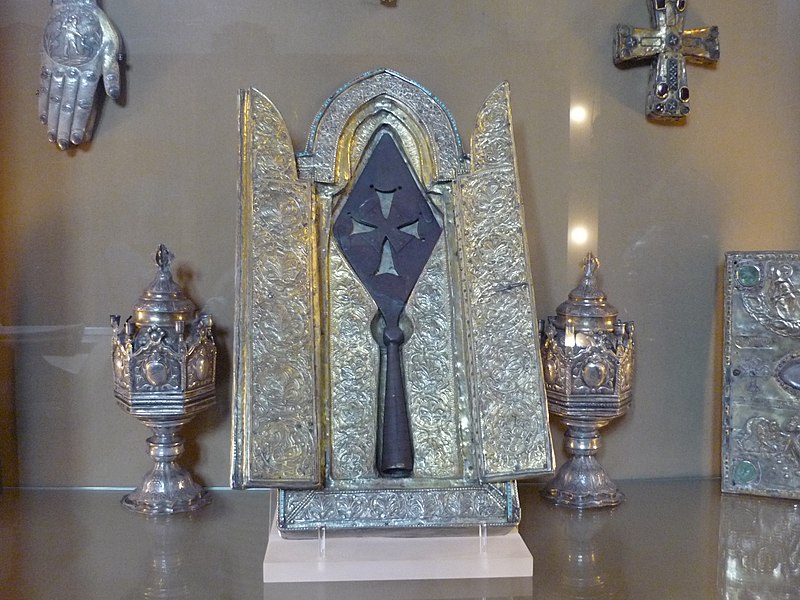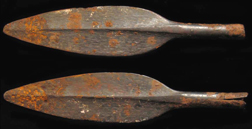
The Holy Lance
He who holds the Holy Lance, holds the destiny of this world in good or evil, but he who looses this spear, looses his life. All through this spear is associated with giving great powers to its users. It has the power to punish them, if they ever lose it.
The Bible mentioned the Holy Lance only in one sentence (Gospel of Saint John 19, 28-37). Holy lance or spear of destiny is the part of early Christian legends. Apparently, this holy artifact was lost for a very long time and miraculously recovered in 1098 (Antioch) by Peter Batholomew. This spear is today known as Armenian holy lance. Probably, this spear isn't genuine, because it doesn't look like a Roman spear. More likely it doesn't look like any spear at all, because it is blunt, and hardily can kill anyone. There are other two spears of destiny. One is held in Vatican, and another is held in Viennese museum.
Hofburg Lance
1. Viennese spear of destiny(the lance of Saint Maurice or Hofburg spear) is probably another medieval artifact. Medieval era was the time when many forgeries were made. Bishops back then were counterfeiting land deeds, so it isn't anything strange, if any of these spears isn't the genuine spear, which was used to pierce crucified Jesus Christ.
The Holy Spear of Antioch
2. Armenian spear of destiny ( Echmiadzin spear) or the Armenian holy lance is historically significant, because it was a moral weapon, which helped a small number of crusaders to beat large number of Islamic armies at a siege of Antioch.

Vatican's Holy Lance
2. Vatican's spear of destiny
This spear was never shown to the public, but looks like a spear on this picture. If that is true, then this spear is 100% Roman, but probably it is another non authentic item from early fourth century.

Krakow's Holy Lance
4. Krakow lance (copy of the Vienna lance). This spear was given to Polish king in year 1000. by German Holy Roman Emperor Otto III. Today, this spear is held in Krakow cathedral. The Krakow spear of destiny is slightly different than the Viennese spear of destiny.
 In 1. Century AD there were two types of Roman spears: hasta and pilum.
In 1. Century AD there were two types of Roman spears: hasta and pilum.1. Roman hasta is the best candidate to be the holy lance. The Roman pilum was the standard equipment of Roman soldiers in 1. century AD. This spear stated its role in times of Roman Republic when Senate (SPQR) ruled. Back then, only the Roman nobility could buy the best armor or weapons like the pilum. These units were called Triarii, and they formed the third line of an attack. Going to war as a Triarii meant to take a bitter end of battle.

2. Roman pilum is a different kind of spear designed to be throw at the enemy before the main battle has commenced. When this spear hits the enemy, it sticks in him, and cannot be easily pulled out, because the top of this spear bend.
Video 1
It is believed that the spear of Christ grants its holders some powers like an invincibility, healing, prolonging natural life and the power of immediate punishment, if the holders lose this spear.
None of these spears appears to be the genuine spear of destiny. Probably, the earliest forgery of the holy lance dates from 312 AD. Roman Western Emperor Constantine was a cult leader who sought a great potential in Christianity. Constantine I was an ambitious politician, who found the way trough Holy Lance which "miraculously" came into his possession, to gain a spiritual authority among Christians.
Another character who came into possession of the spear of destiny was Friedrich Barbarossa ( twelfth century), who died in the Holy Land. This Holy Roman emperor never lost a single battle in his life, but he died from drowning while he was crossing the river. Barbarossa was a fierce warrior. He was greatly respected and feared by his opponents.
Many of the Holy artifacts popped up constantly trough the history. It became even possible for the same Holy artifacts to become present in different places at a same time. Other leaders like a Holy Roman Emperor Charlemagne the Great (800. AD) used the spear of destiny to bypass the bishops and the Pope, and to gain spiritual leadership among people. Nobody ever questioned the authenticity of items. They had a good marketing even then.
(5 gm) .999 Fine Gold Bar - (With Assay Card) PAMP SUISSE
The True Cross

Constantine also came into possession of Holy Cross, which finally miraculously sprang up, when his mother visited Palestine in 329 AD. The finding of Holy Cross is a part of documented facts. According to the story, Constantin's mother visited Palestine and found all three crosses which were mentioned in the New Testament. She distinguished the True Cross by testing it as it had healing ability. The best guess about the Holy cross that it is a very good forgery or maybe genuine item.
The New Testament doesn't give any significance to any forms of holy artifacts. The Word of God is the most significant part of the Old and the New Testament, and not the holy artifacts.
The most common lie is that the "truth" or the word is within us, if that was to be, then we would be Gods what we aren't. The word comes from God, and people aren't Gods. The word never started with us, but it existed before us.
The Arc of the Covenant

The only artifact which possesses documented powers is an Arc of the Covenant. There is a rumor that this Holy artifact which contains 10 commandments is located somewhere in Ethiopia. Arc of the Covenant is the most significant sacred artifact, because it contains the Word of God. Unlike the Bible, which is written by many unknown authors or with an inspiration from God, the 10 commandments are directly written by God himself. Unfortunately, this historic item is lost or maybe just hidden, for some reason.
Possible locations of this artifact are:
- The Temple of Solomon, which was destroyed in 589 BC ( the underground chamber)
- Ethiopia (artifact (or copy of this artifact) was given to the son of Solomon)
- Rome ( taken by Romans when they destroyed the rebuilt temple in 70 AD)
- taken by Babylonians when they destroyed the Temple in 589 BC
- Rome ( taken by Pompey when he conquered and pillaged the Palestine in 63 BC)
- under the mud of river Tiber in Rome
- Egypt ( taken there and buried when the Babylonians conquered the Palestine)
The Arc of the Covenant was lost in the sixth-century BC. There is no mention about it ever again.
The Arc of the Covenant grants an army power of invincibility. When armies of Israel marched with it, they won every single battle except one. They lost only one battle and enemy came into possession of the Arc. Later, the enemy happily returned it back.
(2.5gm) .999 Fine Gold Bar - (With Assay Card)